Did you know that the average American spends ninety, yes, 9-0, percent of their time indoors? It’s true! You’re welcome to visit to my home and observe my two teenagers… This, however, means that our indoor environments are now cesspools of recirculated airborne contaminants: pollen, dust, bacteria, allergens, chemical compounds, flu virus, and now the Corona Virus. These contaminants can cause various illnesses and diseases. Today we’re going to take a brief look at airborne contaminants and what we can do to combat their effects.
The Challenge
Back in the day, the increasing cost of energy required to operate buildings became a concern. The solution was to make buildings “tighter” and reduce the amount of ventilation, resulting in the reduction of energy required to heat and cool outdoor air. Tighter construction and reduced ventilation led to mold, increased Volatile Organic Compounds (VOCs) and Carbon Dioxide from occupants. This was termed Sick Building Syndrome and it doesn’t stop there.

Diagram showing types of contaminants in airstream and their sizes (Click image to see full-size version.)
The diagram1 above gives us an idea of the types of contaminants that are currently surviving in our airstream. A human hair can be anywhere from 20 – 180 micrometers in size and be suspended in the air for seconds. Pollen and droplets, bacteria and aerosols are much smaller in size and can remain suspended in the air for minutes or even hours. The Covid-19 Virus is less than one (1) micrometer in diameter and can be suspended in the air for hours. According to the Center for Disease Control (CDC) and the World Health Organization (WHO), the risk of getting Covid-19 is higher in crowded and inadequately ventilated spaces where infected people spend longer periods of time together in close proximity. Being in an indoor environment that has been tightly constructed, ventilation reduced, while sharing said space with possibly infected people, is a clear recipe for disaster. Unfortunately, this is the exact situation many of our children walk into every day when they enter a school classroom, however we’re learning that:
- Proper ventilation and avoidance of crowded indoor spaces are critical. (CDC)
- Proper control of the building ventilation systems can prevent the spread of contaminants. (WHO)
The American Society of Heating, Refrigerating and Air Conditioning Engineers (ASHRAE) advises that we “change building operations, including the operation of heating, ventilating and air-conditioning systems to reduce airborne exposures to these contaminants.”
The Solution
The Harvard T.H. Chan School of Public Health, ASHRAE, and other organizations are calling for increased air changes in public spaces. The more thoroughly mixed air dilutes contaminants and helps to remove the contaminants faster. We can also capture and reduce source emissions by adding filtration to the process.
The purpose of ASHRAE 62.1-2016 is to specify minimum ventilation rates to provide indoor air quality that is acceptable to human occupants. Looking at the chart on the right, we see that most indoor spaces are getting less than 3 Air Changes per Hour (ACH) of fresh air. The latest recommendations from the ASHRAE Epidemic Task Force2 are increasing the ventilation to 5 – 6 ACH for improved Indoor Air Quality (IAQ) and to lower exposure to airborne pathogens. We can increase the air change rate by increasing the volume of outdoor air, adding MERV 13 or greater filtration to existing systems or by adding local HEPA filtration equipment.1
The chart on the left from the CDC shows the amount of time (in minutes) required to remove 99% of contaminants from a space at a particular air change rate. You can see in the 2 ACH range (our typical indoor space) that it takes over 2 hours for contaminants to clear. If we increase to 6 ACH, it takes about 45 minutes – this is a very significant reduction in potential exposure time to harmful pathogens.
We can ventilate and control indoor spaces through expert HVAC system design and superior products. Dedicated Outdoor Air Systems (DOAS) and air purifiers can be used in conjunction to reduce, capture, dilute and remove contaminants, making this process effective, energy efficient, and inexpensive. We can make this happen using the minimum amount of outdoor air …
Reduce, Capture, Dilution and Removal: These are four keys to ventilating, controlling safe indoor spaces, and improving the quality of the air we breathe. Capture, dilution, and removal of contaminants are the most critical. Let’s take a closer look at how we go about this.
Filtration – Capture and Removal
Both the CDC and ASHRAE are recommending the use of portable High-Efficiency Particulate Air filter (HEPA) systems, with additional consideration to include Ultra-Violet Germicidal Irradiation (UVGI) and Bipolar Ionization (BPI). We can capture and remove contaminants through filtration. When the air passes through the filter fibers, contaminants are captured in various ways. The capture effectiveness is primarily dependent on the particle size, air velocity and physical characteristics of the filter media – thickness, porosity, fiber diameter etc. It is best to add filters with higher filtration rates at the system level, if your system can manage it. Increased filter efficiency leads to increased pressure drop, which can lead to reduced airflow through the HVAC system, potentially larger sized fans, and more energy use for the fan(s) to compensate for the increased static pressure.
Bipolar Ionization – Removal

Four-part image of how Bipolar Ionization (BPI) works to remove contaminants in the airstream (Click image to see full-size version.)
The picture1 above depicts how Bipolar Ionization (BPI) works to remove contaminants in the airstream. In figure 1, airborne particles are charged by the ions, causing them to cluster and get caught in the filter. In figure 2, we see how the ions divide to reproduce. As this happens, bacteria and virus cells are robbed of life-sustaining hydrogen and are destroyed. Odorous gases and aerosols oxidize on contact with oxygen ions and are neutralized in figure 3. Finally, in figure 4, the oxygen ions cause a chemical reaction with VOCs breaking down their molecular structure. Contaminant destroyed!
UVGI – Dilution and Removal
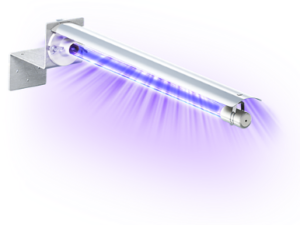
Ultraviolet Germicidal Irradiation (UVGI) is a method in which we introduce the perfect wavelength of ultraviolet light into the airstream, at the right intensity and for a certain amount of time, to dilute and remove contaminants. This killer combo renders microorganisms in the airstream and on surfaces completely inactive.
Displacement Ventilation – Dilution and Removal
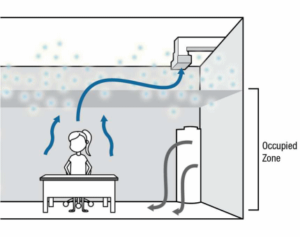
If we’re looking to dilute and remove contaminants on a large scale, displacement ventilation is a great place to start. The room shown on the right1 is outfitted with a corner displacement diffuser and a ceiling-level return diffuser. With a displacement ventilation system, fresh air is injected into the space directly at the occupied zone, at a higher supply air temperature and at a low velocity. This air migrates to thermal plumes (aka humans), rises upward (as warm air), taking contaminants along with it, and exiting the space through the return air system. The displacement system offers up to 46% improvement in ventilation effectiveness.
Purification Technology
While you might think the best purification method is to watch Purple Rain3 and jump into the waters of Lake Minnetonka, we’re going to investigate a few more advanced options.
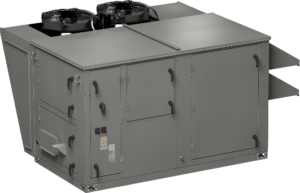
As we learned in our January blog post, a DOAS unit4 is designed to provide 100%, or a large portion, of outside air that is dehumidified and cooled or heated to ventilate a space. The DOAS unit handles the latent (moisture) load in the building while a secondary source handles the sensible (temperature) load at the space. This secondary source can be an air handler, variable air volume (VAV) box, or another type of terminal unit. When used in a displacement ventilation system, the DOAS unit will bring in the MINIMUM required allowable outdoor air to the space, while the terminal units will capture, dilute, and remove the contaminants from the recirculated air. Greenheck’s RV unit is perfect for purification purposes. It not only dilutes with 100% ventilation air, but this unit can also be equipped with UVGI and Needlepoint BPI. The RV has an option for energy recovery and can even accommodate partial recirculation if your application calls for it.
Learn more about Greenheck’s DOAS Units here.
For new or retrofit applications, Price Industries offers a number of terminal units to satisfy your new ACH requirements. With Price purifiers, we can help increase ventilation rates from 2 to 6 ACH without having to overhaul an existing HVAC system. In this example, we’re using the Overhead Air Purifier (OAP) to increase the room from 3 ACH to 6 ACH, meeting the Harvard recommendation. This OAP is equipped with a HEPA filter, UVGI and BPI. The OAP is a permanent solution which requires no HVAC system modification for installation, is hidden above the ceiling, integrates with standard ceiling diffusers and is quiet (Noise Criteria (NC) of 26 – 51 @ 1,000 cfm).
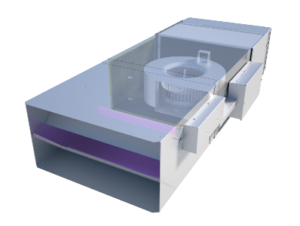
Classroom – 1,000 SF
475 CFM Fresh Air (3.17 ACH) (Bare Minimum)
5 ACH – 3.17 ACH = 1.83 ACH or 275 CFM
2-3 ACH of fresh air in modern classroom is typical
Overhead Air Purifier
275 CFM
Result
6.0 ACH @ NC 32 (Excellent)
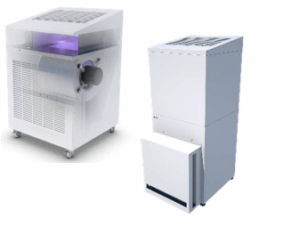 In the event of an immediate need for retrofit in a large space, a portable Room Air Purifier (RAP)1 is ideal. The Price RAP was designed to be a frontline fighter against Covid-19 for the school classroom. The RAP utilizes filtration, ultra-violet light, and bipolar ionization to render nearly 100% of airborne coronavirus particulates ineffective. It is portable with lockable casters, is plug and play (no contractor or electrician required) and is available with Quiet (Q) technology (below NC-30). The RAP can be maneuvered to more densely occupied locations and turned off when the space is not in use.
In the event of an immediate need for retrofit in a large space, a portable Room Air Purifier (RAP)1 is ideal. The Price RAP was designed to be a frontline fighter against Covid-19 for the school classroom. The RAP utilizes filtration, ultra-violet light, and bipolar ionization to render nearly 100% of airborne coronavirus particulates ineffective. It is portable with lockable casters, is plug and play (no contractor or electrician required) and is available with Quiet (Q) technology (below NC-30). The RAP can be maneuvered to more densely occupied locations and turned off when the space is not in use.
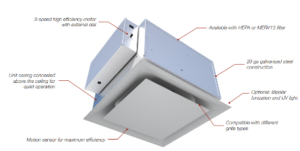 For your smaller spaces, Price makes a RAP-mini1 or a Ceiling Air Purifier1 (CAP). Both options can operate from 50 – 200 cfm, come with a 3-speed fan for efficiency, and motion sensor control. The RAP-mini is plug and play. The CAP can be installed into a 2×2 grid ceiling. Both utilize HEPA filtration, UVGI and BPI for optimum filtration.
For your smaller spaces, Price makes a RAP-mini1 or a Ceiling Air Purifier1 (CAP). Both options can operate from 50 – 200 cfm, come with a 3-speed fan for efficiency, and motion sensor control. The RAP-mini is plug and play. The CAP can be installed into a 2×2 grid ceiling. Both utilize HEPA filtration, UVGI and BPI for optimum filtration.
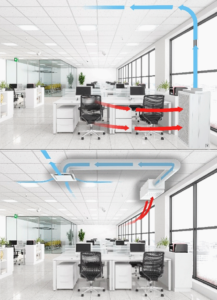
Price Puraflo unit, floor mounted (top image) and ceiling mounted (bottom)
(Click for full-size version.)
The Price Puraflo 1 is a temp-to-permanent purification solution. The unit can be floor mounted for immediate use and be transferred to any standard t-bar ceiling for permanent use. This unit has cleanroom-grade construction, HEPA gel seal preventing filter bypass and low maintenance room-side replaceable filter. The Puraflo is an excellent solution for schools and hospitals as you can install the unit immediately, and wait until there is a break in the schedule or the summer months to install above the ceiling.
Learn more about Price Air Purification Products Here.
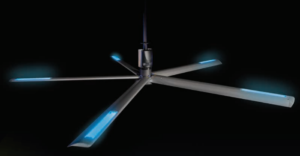 Greenheck has applied its patented Northern Lights UV-C technology into its AMPLIFY Fan5. Non-ozone generating UV-C bulbs are installed inside the AMPLIFY fan blades and positioned toward the tips of the blades where the majority of air movement occurs for the most effective inactivation of pathogens. As the fan operates, contaminated air from the lower portion of the room is circulated to the ceiling where it is exposed to powerful UV-C light as it moves across the fan’s blades. UV output is customizable for effective yet safe pathogen inactivation in the space. Controls are available for effortless operation of 1 to multiple fans.
Greenheck has applied its patented Northern Lights UV-C technology into its AMPLIFY Fan5. Non-ozone generating UV-C bulbs are installed inside the AMPLIFY fan blades and positioned toward the tips of the blades where the majority of air movement occurs for the most effective inactivation of pathogens. As the fan operates, contaminated air from the lower portion of the room is circulated to the ceiling where it is exposed to powerful UV-C light as it moves across the fan’s blades. UV output is customizable for effective yet safe pathogen inactivation in the space. Controls are available for effortless operation of 1 to multiple fans.
Learn more about Greenheck Amplify Fans with Northern Light Technology here.
The Play-UV by EffectiV HVAC is a 360-degree adjustable high induction UV diffuser that is suitable for any ceiling type. This diffuser combines UV-C irradiation, air filtration, and air mixing to improve ventilation in your space.

This plenum-style diffuser is equipped with a MERV-7 or MERV-9 filter to capture larger particle contaminants. The filter also helps to pressurize and slow down the air inside the plenum. With the airflow significantly slower, the diffuser irradiates contaminants with a high dose of UV-C light, increasing disinfection efficiency. The adjustable diffuser swirls induce mixing of fresh air with the room air, improving ventilation and thermal comfort. The UV diffusers do not emit any ozone or harmful particles, and are UL certified in the USA and Canada.
 We’ll end our discussion on Price’s Displacement Ventilation Products1, which we touched on earlier in this blog. With Displacement Diffusers, ventilation air is stratified, capturing airborne contaminants, and removing them at a location above the occupied zone. Due to the nature of the system, Displacement Diffusers can be located anywhere and practically melt into the space aesthetics. Displacement Diffusers come in various shapes and sizes and suit applications from the education sector to industrial environments, hospitals, and many others.
We’ll end our discussion on Price’s Displacement Ventilation Products1, which we touched on earlier in this blog. With Displacement Diffusers, ventilation air is stratified, capturing airborne contaminants, and removing them at a location above the occupied zone. Due to the nature of the system, Displacement Diffusers can be located anywhere and practically melt into the space aesthetics. Displacement Diffusers come in various shapes and sizes and suit applications from the education sector to industrial environments, hospitals, and many others.
Learn more about Price Displacement Ventilation Productions here.
To learn more about our Purification products, be sure to contact your local Brucker representative.
References:
- Mahon, M. (n.d.), Application Engineering Manager, Price Industries. From: Solutions for Reducing Airborne Pathogens.
- ASHRAE Epidemic Task Force: Core Recommendations for Reducing Airborne Infectious Aerosol Exposure. October 19, 2021. https://www.ashrae.org/file%20library/technical%20resources/covid-19/core-recommendations-for-reducing-airborne-infectious-aerosol-exposure.pdf
- Prince and The Revolution. “Purple Rain.” Purple Rain. Warner Bros. Records and Purple Films Company, 1984.
https://www.discogs.com/release/194021-Prince-And-The-Revolution-Purple-Rain / https://catalog.afi.com/Catalog/MovieDetails/57174 - Dedicated Outdoor Air Systems – Greenheck USA. Greenheck. (n.d.). Retrieved February 23, 2022, from https://content.greenheck.com/public/DAMProd/Original/10002/rv_rve_catalog.pdf
- Greenheck Amplify Fan with Northern Light Technology – Greenheck USA. Greenheck. (n.d.). Retrieved March 25, 2022, from https://content.greenheck.com/public/DAMProd/Original/10015/HVLS_NorthernLight_brochure.pdf

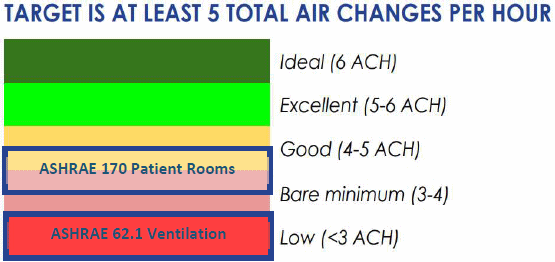
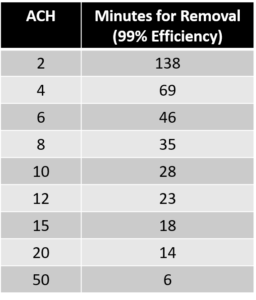
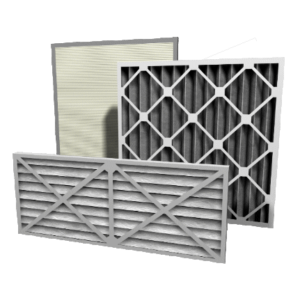
Recent Comments